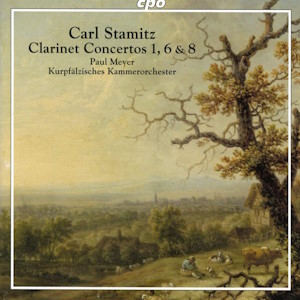
Carl Stamitz (1745-1801)
Concertos for Clarinet and Orchestra Volume 2
Clarinet Concerto No. 1 in F major
Clarinet Concerto No. 6 in E flat Major
Clarinet Concerto No. 8 in B flat major
Kurpfälzisches Kammerorchester/ Paul Meyer (clarinet)
rec. 2020, Epiphaniaskirche, Mannheim, Freudenhem, Germany
cpo 555 415-2 [51]
The second half of the eighteenth century and the early nineteenth century saw the rise of the clarinet. The instrument now offered increased technical possibilities. That, in turn, attracted outstanding virtuosi who wanted to show off their abilities, and composers willing to write for an instrument which represented the contemporary trends.
Carl Stamitz, the son of Johann Stamitz, lived his early life in Mannheim, where the famous orchestra played modern symphonies by composers such as his father, Carl Cannabich and Christoph Graupner. Carl became a virtuoso violinist and travelled widely. In his clarinet concerti, written probably in the 1770s, he uses the full range of the instrument. That especially meant the lower register, excitingly novel, which allowed the orchestra more space to develop its own character, including the famed ‘Mannheim crescendo’.
These works have a similar pattern. The opening sonata-form Allegro with a cadenza is the longest movement. The middle movement is an elegant and lyrical Andante in the F major concerto, a Siciliano in the E flat major concerto, and an Adagio in the B flat major concerto. The finale is always a Rondeau, as it is a few decades later in the clarinet concertos by Carl Maria von Weber (1786-1826) and Berhard Crusell (1775-1838), and in Mozart’s Concerto K622.
There is a little uncertainty about the authorship of the E flat Concerto. The first movement is particularly virtuosic, and in the manuscript there also is the name ‘Beer’. I assume that it means the clarinettist Joseph Beer (1744-1812). The concerto may be a ‘re-vamping’ of a Stamitz concerto. It even contains passages from Concerto No. 1.
Christian Schubart (1739-1791) described Stamitz as a ‘sweet setter of melodies’. Mozart called him ‘a miserable note-scrawler’. Both are somewhat right. Stamitz, not just in these works but in the symphonies, could write memorably beautiful melodic lines but there are also many passages of note-spinning or musical water-treading.
I missed volume 1 in this series, concerti No. 3-5. There may be another volume since Stamitz composed no fewer than eleven clarinet concertos. Soloist Paul Meyer also directs his fine chamber orchestra. Lorenz Adamer’s handy and interesting essay discusses the individual concertos in a little detail.
These attractive works are excitingly played and spaciously recorded. Even so, they do not represent Stamitz at his most inventive. For that, I would want to turn to the symphonies; he wrote no fewer than fifty. Several of them can rise to the heights of early Haydn.
Gary Higginson
Help us financially by purchasing from




















